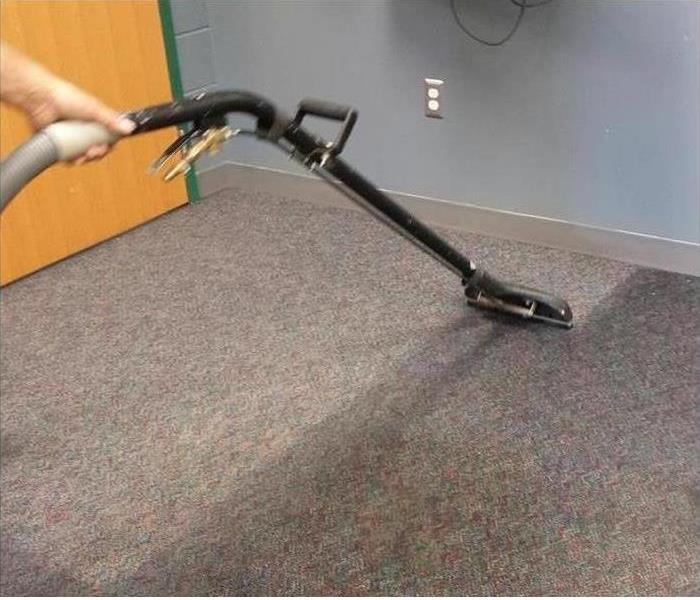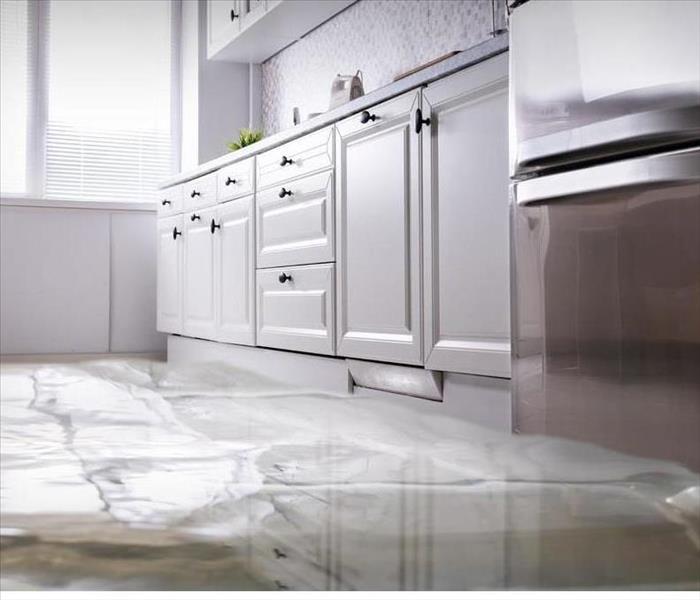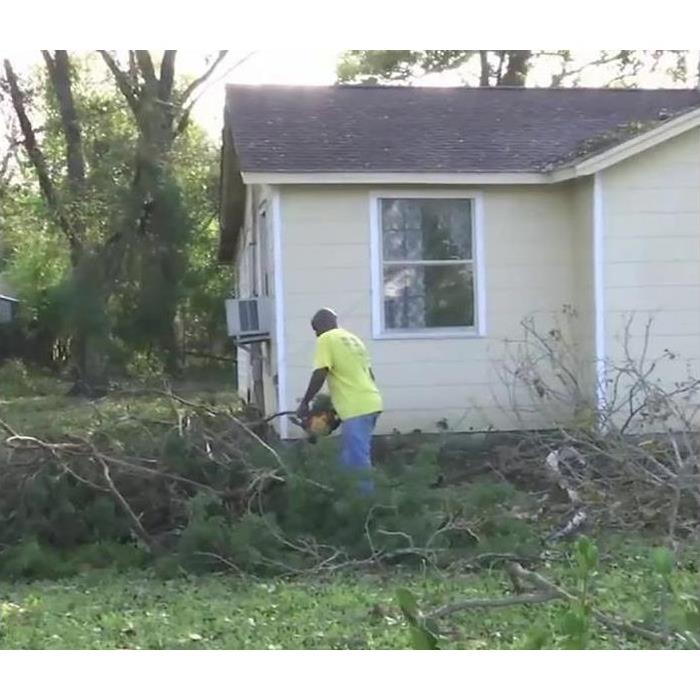Recent Water Damage Posts
Dealing with Flood Damage: Immediate Steps to Take Before Help Arrives
10/21/2024 (Permalink)
Floods can cause extensive damage to your home, but taking immediate action can help minimize the impact. Here are some steps to take before professional help arrives:
1. Ensure Safety First
Before entering your home, ensure it is safe to do so. Check for electrical hazards and structural damage. If there is standing water near electrical outlets or appliances, do not enter until a professional has assessed the situation.
2. Stop the Water Source
If the flooding is due to a burst pipe or another internal source, try to stop the flow of water if it's safe to do so. This may involve turning off the main water supply to your home.
3. Remove Excess Water
If possible, remove excess water using mops, buckets, or a wet/dry vacuum. Be cautious of contaminated water, and avoid using electrical appliances if the area is wet.
4. Move Furniture and Valuables
Move furniture, electronics, and other valuables to a dry area to prevent further damage. Place aluminum foil or wooden blocks under furniture legs to avoid staining carpets or flooring.
5. Ventilate the Area
Open windows and doors to allow for better air circulation. This helps with the drying process and reduces the potential for mold growth. If you have fans or dehumidifiers, use them to assist in drying out the affected areas.
6. Document the Damage
Take photographs and videos of the flood damage for insurance purposes. Documenting the extent of the damage can help with your insurance claim and ensure you receive adequate compensation.
7. Avoid Contaminated Water
Floodwater can be contaminated with bacteria, chemicals, and other hazardous materials. Avoid direct contact with floodwater and wear protective gear if you need to enter affected areas.
8. Contact Your Insurance Company
Notify your insurance company about the flood damage as soon as possible. They can provide guidance on the claims process and may help arrange for professional assistance.
9. Call SERVPRO® for Professional Help
Once you’ve taken the initial steps, contact SERVPRO for professional water damage restoration services. Our team is equipped to handle the full scope of water damage, from extraction and drying to cleaning and restoration.
By following these immediate steps, you can help mitigate the damage caused by flooding and ensure a smoother restoration process when professional help arrives.
How does your home rate in preventing water damage?
3/20/2022 (Permalink)
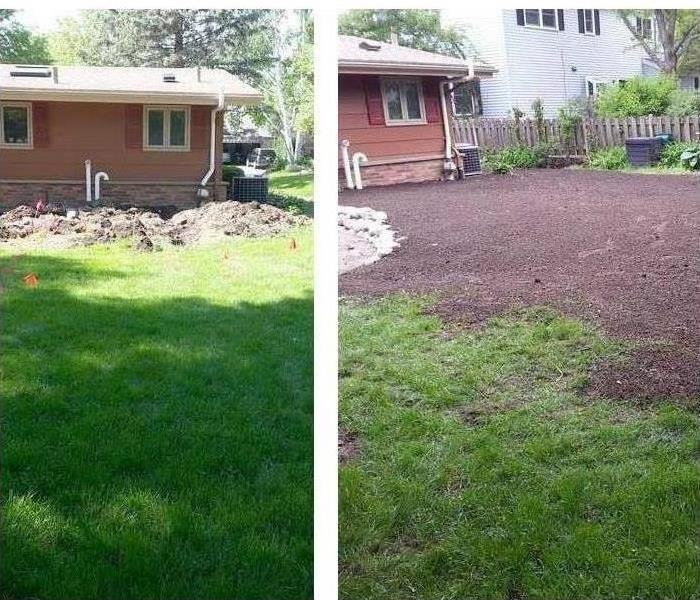 Making sure that your yard is graded correctly is important
Making sure that your yard is graded correctly is important
Certain factors which eliminate the potential for water damage should be a top priority whether you are shopping for a pre-existing home or property on which you plan to build your own home. Yard grading is a construction or landscaping technique that changes a property’s directional slope.
A pre-existing home that sits on land that slopes downward towards its foundation could be in for destruction after heavy rains, storms and melting snow. Changing the grade to slope away from its foundation effectively could eliminate these risks.
Yard grading around a pre-existing structure can be accomplished by clearing all landscaping within a five-foot area around the home’s perimeter. Low-lying spots or lawn dips could result in post-storm mud and small pools of water. Fill the dips up with clean soil and use a compactor to tamp down the soil.
Another method some homeowners choose to employ is to install a dry creek bed straight up the middle of their land and fill it in with attractive river rocks. This bed-like feature draws runoff deep down into the earth, keeping above-ground outbuildings dry.
If you are considering designing your own home, it’s a lot cheaper to change the home's design than regrade the ground. Draw home plans with the structure on highest ground point. Try to leave at least six inches between the home’s perimeter and landscape plantings.
Some homeowners install gutter systems that are easy to maintain consistently or place river rocks around downspouts, so runoff doesn’t create sinkholes. Homeowners may choose to install double-pane windows or water resistant flooring. Central heat and air units with dehumidifying systems could also help. Area rugs made from natural fibers that are washable and furniture made of moisture repellent materials like bamboo could also prevent moisture build up. Be sure to insulate any plumbing against condensation and
seal air ducts thoroughly, paying close attention to adjoining seams.
Once you have established a safe, water-tight home environment, you are ready to move into your new residence.
Your attic and water damage-is it preventable!
3/14/2022 (Permalink)
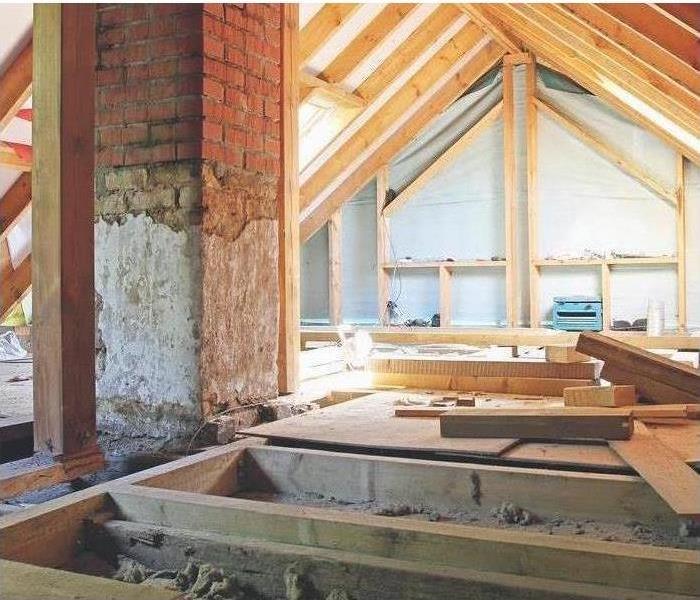 Have you inspected your attic lately?
Have you inspected your attic lately?
Water and moisture in an attic can cause major headaches and costly repairs. Also, mold can grow and contaminate your home's air quality, and water can even weaken its structure. Homeowners need to know what causes the moisture in their attic in order to stop water damage. The damage could come from a leaking roof, faulty insulation and/or ventilation or appliance failures. SERVPRO of Lenoir, Duplin & Jones Counties offer these helpful tips at how to reduce attic water damage:
Look for Leaks in Your Attic-Check the insulation and wood for signs of water damage like mold or discoloration of the wood. Also, check around where the light fixtures are paced from above.
Ventilate Your Attic-Moisture in your attic space increases without the proper ventilation. Good attic ventilation is especially important in winter, because in winter, warm air rises, enters the attic, and then condenses on any cold surfaces of the attic. Condensation can’t be released unless your attic has the proper ventilation. Also, make sure any attic vents are open and not blocked by insulation or clutter.
Insulate Your Attic-The temperature levels in your attic are controlled by the insulation you use. In the winter months, the attic temperature should be five to ten degrees warmer than the outside temperature. The attic floor needs to be properly insulated so warm air from inside your house doesn’t enter the attic.
Vent Appliances to the Outside-A common mistake a lot of homeowners experience is improper ventilation of appliances. The clothes dryer, kitchen vents, and bathroom vents should always blow the air outside of the house and not in the attic.
Maintain Attic Appliances-One other thing to note is that appliances in your attic such as air conditioners, hot water heaters, and HVAC systems may fail and cause water damage. Remember to periodically check these appliances for wear and tear and loose connections.
How does water extraction help prevent secondary damage?
11/20/2021 (Permalink)
After a Lenoir, Duplin or Jones county residence takes on water from a water leak, restoring a dry interior becomes essential to protecting the home's structure and contents from additional harm. Because water quickly evaporates and turns to water vapor, and then, soon after, condense on other surfaces, it is almost impossible to contain lost water.
If your property is holding water where it should be dry, SERVPRO's water extraction team in Kinston can get things dry, check for current damaged areas, and carry out preventative measures that enhance the work we do. Different materials absorb and retain water, as well as exhibit different ways in which exposure to water affects them. The drying rates also differ between various elements. Knowledge of this information helps us determine the best methods to use while working on your home.
Water extraction begins with an assessment of the area which provides us with valuable information about the materials involved and the amount of water we need to remove. Part of our water extraction work includes removing waterlogged sections of carpet and drywall. Sometimes we can restore carpeting, but this depends on several factors.
Removing the moisture that microbes need to grow and destroy materials inside your dwelling, as well as stain clothing and other personal belongings, happens when we remove the water vapor these microorganisms require. Without this extra source of moisture, your home's interior structures and contents remain safe from the effects of microorganisms. Mold damage is not the only type of secondary water damage that homes face when water exists in living areas.
Stained sections of ceilings in levels below where the accident took place can appear later. The stains are not because of mold, but the discoloration happens when minute particles leach through the drywall and paint. Other problems that can affect a ceiling include warping. Warped ceilings can become highly risky, as they can collapse from the weight of any trapped water. SERVPRO knows how to rectify both situations and make your home “Like it never even happened.”
Wooden floors and edging that gets wet can become permanently damaged. SERVPRO knows how to dry such aspects of your home, so existing damage decreases in scope. We use industry-accepted procedures, helping these natural components of your home regain their original look as much as possible.
SERVPRO of Lenoir, Duplin & Jones Counties can help you get your home restored after a disaster involving water with our water extraction experts. Holding IICRC certificates in several different areas, we are prepared to take care of every aspect of your home saturated by the water. Contact us by calling our 24-hour service line number 252-208-7888, 365 days a year.
What is the process if we have standing water in our home?
11/4/2021 (Permalink)
Imagine waking up in the wee hours of the morning stepping out from your bed onto squishy wet carpet! The toilet had been running for hours. You stop the water source but what do you do next? Call SERVPRO of Lenoir, Duplin & Jones Counties! But what comes next? Here is what to expect-
Step 1: Emergency Contact
Call SERVPRO of Lenoir, Duplin & Jones Counties at 252-208-7888 and we will answer the phone ready to help. SERVPRO of Lenoir, Duplin & Jones Counties have trained professionals to answer your call. Expect to tell them your name, phone number, and address.
Step 2: Inspection
Our technician will arrive onsite to scope the damage by identifying the water source, the type of water, and survey the extent of the water damage.
Step 3: Water Extraction
With the use of water removal equipment such as truck-mounted vacuums or pumps, we quickly remove hundreds or thousands of gallons of water from your property. During this process we also inspect the materials that may need to be removed for proper drying of the structure.
Step 4: Drying and Dehumidification
Our Professionals will use room measurements, temperature, and relative humidity to determine the optimal number of air movers and dehumidifiers to dry your home or business. We’ll carefully monitor the progress using moisture meters until the materials return to acceptable drying goals.
Step 5: Cleaning and Repair
SERVPRO of Lenoir, Duplin & Jones Counties specializes in restoring contents damaged by fire, water, or mold. Our expertise and training can help you save money while preserving precious keepsakes that can’t be replaced. Some of our restoration tools include carpet cleaning, deodorization, and sanitizing treatments.
Step 6: Restoration
Restoration, the final step, is the process of restoring your home or business to its pre-water damage condition. Restoration may involve minor repairs, such as replacing drywall and installing new carpet, or may entail major repairs, such as the reconstruction of various areas or rooms in a home or business.
We will work alongside your insurance company and adjuster to make sure we get your property restored to it's pre loss condition, saving you time and money.
What is the process for water damage restoration?
9/3/2020 (Permalink)
Imagine waking up in the wee hours of the morning stepping out from your bed onto squishy wet carpet! The toilet had been running for hours. You stop the water source but what do you do next? Call SERVPRO of Lenoir, Duplin & Jones Counties! But what comes next? Here is what to expect-
Step 1: Emergency Contact
Call SERVPRO of Lenoir, Duplin & Jones Counties at 252-208-7888 and we will answer the phone ready to help. SERVPRO of Lenoir, Duplin & Jones Counties have trained professionals to answer your call. Expect to tell them your name, phone number, and address.
Step 2: Inspection
Our technician will arrive onsite to scope the damage by identifying the water source, the type of water, and survey the extent of the water damage.
Step 3: Water Extraction
With the use of water removal equipment such as truck-mounted vacuums or pumps, we quickly remove hundreds or thousands of gallons of water from your property. During this process we also inspect the materials that may need to be removed for proper drying of the structure.
Step 4: Drying and Dehumidification
Our Professionals will use room measurements, temperature, and relative humidity to determine the optimal number of air movers and dehumidifiers to dry your home or business. We’ll carefully monitor the progress using moisture meters until the materials return to acceptable drying goals.
Step 5: Cleaning and Repair
SERVPRO of Lenoir, Duplin & Jones Counties specializes in restoring contents damaged by fire, water, or mold. Our expertise and training can help you save money while preserving precious keepsakes that can’t be replaced. Some of our restoration tools include carpet cleaning, deodorization, and sanitizing treatments.
Step 6: Restoration
Restoration, the final step, is the process of restoring your home or business to its pre-water damage condition. Restoration may involve minor repairs, such as replacing drywall and installing new carpet, or may entail major repairs, such as the reconstruction of various areas or rooms in a home or business.
Thunderstorms 101
8/19/2020 (Permalink)
What is a thunderstorm?
A thunderstorm is a rain shower during which you hear thunder. Since thunder comes from lightning, all thunderstorms have lightning.
Why do I sometimes hear meteorologists use the word “convection” when talking about thunderstorms?
Usually created by surface heating, convection is upward atmospheric motion that transports whatever is in the air along with it—especially any moisture available in the air. A thunderstorm is the result of convection.
What is a severe thunderstorm?
A thunderstorm is classified as “severe” when it contains one or more of the following: hail one inch or greater, winds gusting in excess of 50 knots (57.5 mph), or a tornado.
How many thunderstorms are there?
Worldwide, there are an estimated 16 million thunderstorms each year, and at any given moment, there are roughly 2,000 thunderstorms in progress. There are about 100,000 thunderstorms each year in the U.S. alone. About 10% of these reach severe levels.
When are thunderstorms most likely?
Thunderstorms are most likely in the spring and summer months and during the afternoon and evening hours, but they can occur year-round and at all hours. Along the Gulf Coast and across the southeastern and western states, most thunderstorms occur during the afternoon. Thunderstorms frequently occur in the late afternoon and at night in the Plains states.
What kinds of damage can thunderstorms cause?
Many hazardous weather events are associated with thunderstorms. Under the right conditions, rainfall from thunderstorms causes flash flooding, killing more people each year than hurricanes, tornadoes or lightning. Lightning is responsible for many fires around the world each year, and causes fatalities. Hail up to the size of softballs damages cars and windows, and kills livestock caught out in the open. Strong (up to more than 120 mph) straight-line winds associated with thunderstorms knock down trees, power lines and mobile homes. Tornadoes (with winds up to about 300 mph) can destroy all but the best-built man-made structures.
Where are severe thunderstorms most common?
The greatest severe weather threat in the U.S. extends from Texas to southern Minnesota. But, no place in the United States is completely safe from the threat of severe weather.
We get to water damage FASTER
5/23/2019 (Permalink)
- Water and flood emergencies hardly ever wait for regular business hours and neither does SERVPRO of Lenoir, Duplin and Jones Counties. We provide emergency cleaning and restoration services 24 hours a day, 7 days a week—including holidays.
Water damage is very aggressive. Water can swiftly spread throughout your home and could get consumed into your floors, walls, furniture, and more. SERVPRO arrives quickly and begins the water extraction process almost immediately. This quick response helps to minimize the damage and the cleaning and restoration costs.
Water Damage Timetable
Within Minutes
- Water quickly spreads throughout your home, penetrating everything in its path.
- Water is absorbed into walls, floors, upholstery, and your belongings.
- Furniture finishes may run, causing permanent staining on carpets.
- Photographs, books, and other paper goods start to swell and distort.
Hours 1 - 24:
- Drywall begins to bulge and break down.
- Metal surfaces begin to tarnish.
- Furniture begins to swell and crack.
- Dyes and inks from cloth and paper goods spread and stain.
- A moldy odor appears.
48 Hours to 1 Week:
- Mold and mildew may grow and multiply.
- Doors, windows, and studs swell and warp.
- Metal begins to rust and corrode.
- Furniture warps and shows signs of mold.
- Paint begins to blister.
- Wood flooring swells and go out of shape.
- Serious biohazard contamination is possible.
More Than 1 Week:
- Restoration time and cost increase significantly; replacing tainted materials and structural rebuilding may be extensive.
- Structural safety, mold growth, and biohazard contaminants create serious risks to residents.
About SERVPRO of Lenoir, Duplin and Jones Counties
SERVPRO of Lenoir, Duplin and Jones Counties specializes in the cleanup and restoration of residential and commercial property after a fire, smoke or water damage event. Our staff is highly trained in property damage restoration. From initial and ongoing training at SERVPRO’s corporate training facility to regular IICRC-industry certification, rest assured our staff is equipped with the knowledge to restore your property.
Need Emergency Services?
Call Us 24/7 (252) 208-7888
Your attic and water damage-It is preventable
4/17/2019 (Permalink)
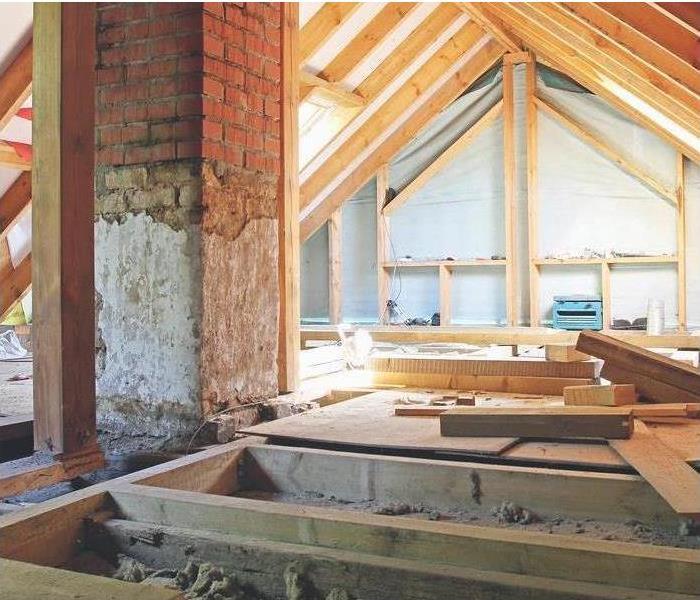 These tips can be useful in the prevention of water damage in your attic
These tips can be useful in the prevention of water damage in your attic
Water and moisture in an attic can cause major headaches and costly repairs. Also, mold can grow and contaminate your home's air quality, and water can even weaken its structure. Homeowners need to know what causes the moisture in their attic in order to stop water damage. The damage could come from a leaking roof, faulty insulation and/or ventilation or appliance failures. SERVPRO of Lenoir, Duplin & Jones Counties offer these helpful tips at how to reduce attic water damage:
Look for Leaks in Your Attic-Check the insulation and wood for signs of water damage like mold or discoloration of the wood. Also, check around where the light fixtures are paced from above.
Ventilate Your Attic-Moisture in your attic space increases without the proper ventilation. Good attic ventilation is especially important in winter, because in winter, warm air rises, enters the attic, and then condenses on any cold surfaces of the attic. Condensation can’t be released unless your attic has the proper ventilation. Also, make sure any attic vents are open and not blocked by insulation or clutter.
Insulate Your Attic-The temperature levels in your attic are controlled by the insulation you use. In the winter months, the attic temperature should be five to ten degrees warmer than the outside temperature. The attic floor needs to be properly insulated so warm air from inside your house doesn’t enter the attic.
Vent Appliances to the Outside-A common mistake a lot of homeowners experience is improper ventilation of appliances. The clothes dryer, kitchen vents, and bathroom vents should always blow the air outside of the house and not in the attic.
Maintain Attic Appliances-One other thing to note is that appliances in your attic such as air conditioners, hot water heaters, and HVAC systems may fail and cause water damage. Remember to periodically check these appliances for wear and tear and loose connections.



 24/7 Emergency Service
24/7 Emergency Service


